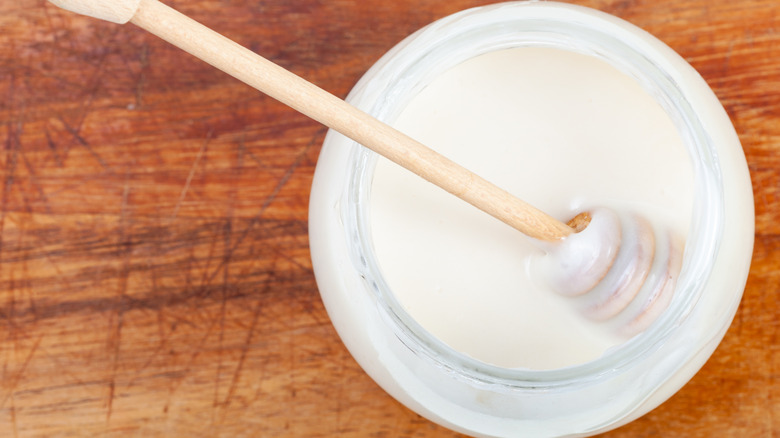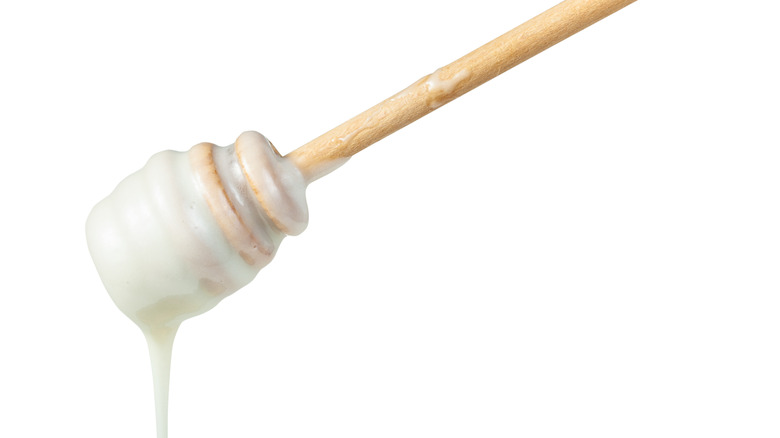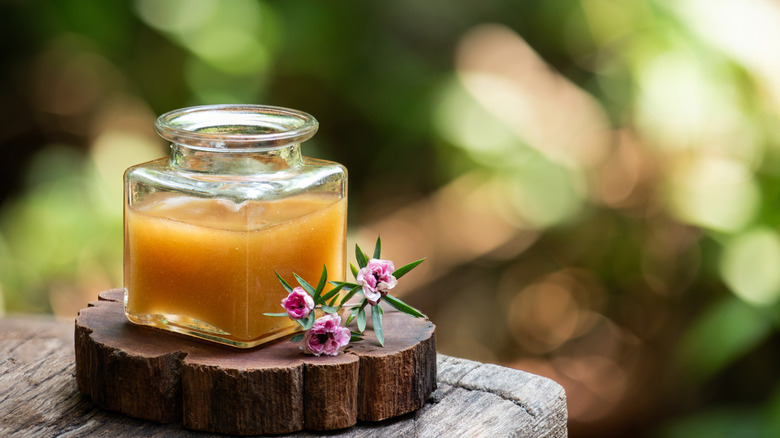The Rare Hawaiian Honey With A Menthol Aftertaste
Honey is one of those culinary treasures that's worth its weight in gold. The bee-created sustenance isn't just delicious, it's nuanced too: Depending on where it originates from, you can find varieties that appear and taste much different from one another, and some are even much rarer than others. In fact, one of the rarest varieties of honey in the world comes from the United States, specifically from the tropics of Hawaii.
Kiawe honey has a creamy texture and a light hue to it, and it's particularly rare because the kiawe tree is threatened in its natural habitat of Ecuador, Columbia, and Peru, but it still grows in Hawaii. It's a monofloral honey, meaning each batch comes from bees that have only fed on nectar from the kiawe tree, which makes it doubly unique. Those who have had kiawe honey describe it has having a tropical flavor; some catch gentle shades of menthol, vanilla, or almond in it. And because of its rarity, kiawe honey comes at premium prices, ranging from $9 for a 3 oz. jar to just over $40 for a 20 oz. one at retailers such as Rare Hawaiian Honey Company.
Part of what makes kiawe honey so unique
Some versions of kiawe honey have a unique characteristic that immediately set it apart from the honey you have in your pantry right now: It's white. This is because it crystalizes rapidly, which also gives it a texture described as creamy. But harvesting it takes some serious skill, because if the honey becomes overripe, it'll solidify to the point where it can't be extracted without the application of heat — which can change the way the honey tastes, feels, and looks, as well as destroying the unique enzymes within it.
As to uses, since the honey is so rare, it's generally recommended to use it without too much fuss. Some reviewers on retail sites say they've used it in tea, on charcuterie boards, and simply by itself, eating it straight from the jar. One seller, World of Honey, says, "It's a perfect match for toast, strawberries and cream, or as we often say -– right by the spoonful." For something that rare, I really do think enjoying it as-is is probably the way to go, at least at first, since honey by itself has that complex floral flavor that I think gets taken for granted sometimes. And in the case of kiawe honey, you should probably savor it, especially due to its rarity.
Other rare honeys exist in the world
Other rare types of honey include manuka honey, which is produced in Australia and New Zealand. It's particularly notable for the fact that it contains a compound called methylglyoxal, which is known to have an antibacterial effect. That means not only can you eat this stuff, you can think about it as edible medicine, too. Then there's Pitcairn honey, which comes exclusively from Pitcairn Island. Since it too is a reflection of its locale, Pitcairn honey has tropical notes to it (Pitcairn Island is located in the South Pacific), and it's described as having flavors of guava, passion flowers, and mango.
Since honey's also a domestic product, sourcing it from across the world isn't exactly necessary unless you've got extraordinary amounts of cash to burn. It's already a remarkable creation, since it really does last indefinitely, and the transformed flower nectar is a natural powerhouse in the kitchen. You can do things like ferment garlic in it, make your own hot honey, and even recreate Chipotle's recipe for honey vinaigrette at home. Might as well use it where you can.
And let's not forget to marvel over how it's created — the fact that bees can take flower nectar and transform it into something humans can eat is pretty incredible, when you think about it. The fact that rare versions exist across the world is just another reason why honey may in fact be one of nature's perfect foods.


